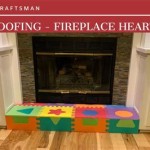```html
Tile For Fireplace Mantel: A Comprehensive Guide
The fireplace mantel serves as a focal point in many homes, providing both aesthetic charm and a functional surface for displaying decorative items. When considering materials for a fireplace mantel, tile emerges as a versatile and durable option. Tile offers a wide array of styles, colors, and textures, allowing homeowners to customize their fireplace to match their personal taste and the overall design of the room. This article provides a comprehensive overview of using tile for a fireplace mantel, exploring the different types of tile available, the installation process, design considerations, and maintenance tips.
Types of Tile Suitable for Fireplace Mantels
The selection of tile for a fireplace mantel significantly impacts the overall appearance and longevity of the structure. Various types of tile possess different characteristics that make them suitable for this application. Understanding these differences is crucial for making an informed decision.
Ceramic Tile: Ceramic tile is a popular choice for fireplace mantels due to its affordability, versatility, and ease of maintenance. It is manufactured from clay and fired at high temperatures, resulting in a durable and water-resistant surface. Ceramic tile is available in a wide range of colors, patterns, and sizes, making it a flexible option for various design styles. Furthermore, ceramic tile is relatively easy to cut and install, making it a cost-effective option for homeowners.
However, ceramic tile may not be as durable as other tile options and can be prone to chipping or cracking if subjected to impact. It also has a lower heat resistance compared to porcelain or natural stone tiles. Therefore, when using ceramic tile for a fireplace mantel, it's important to consider the level of heat exposure and the potential for physical damage.
Porcelain Tile: Porcelain tile is a denser and more durable alternative to ceramic tile. It is made from finer clay and fired at higher temperatures, resulting in a harder and less porous material. Porcelain tile is highly resistant to water absorption, staining, and scratching, making it an ideal choice for high-traffic areas and areas exposed to moisture. It also offers excellent heat resistance, making it suitable for fireplace mantels that are frequently exposed to heat.
Porcelain tile is available in a wide range of styles, including those that mimic the appearance of natural stone, wood, and concrete. This allows homeowners to achieve the desired aesthetic without the higher cost and maintenance requirements of natural materials. However, porcelain tile can be more expensive and difficult to cut than ceramic tile, requiring specialized tools and skills for installation.
Natural Stone Tile: Natural stone tiles, such as marble, granite, slate, and travertine, offer a luxurious and timeless look for fireplace mantels. Each type of stone has unique characteristics in terms of color, texture, and veining, adding character and sophistication to the fireplace area. Marble is known for its elegant veining and smooth surface, while granite offers exceptional durability and resistance to heat and staining. Slate provides a rustic and textured appearance, and travertine features a porous surface with a warm, earthy tone.
Natural stone tiles are generally more expensive than ceramic or porcelain tiles and require more maintenance. They can be porous and susceptible to staining, so it's important to seal them properly and clean them regularly with appropriate cleaning products. Installation of natural stone tile can also be more challenging due to its weight and hardness, often requiring professional assistance.
Glass Tile: Glass tile offers a sleek and modern look for fireplace mantels. It is available in a wide range of colors, shapes, and sizes, and can be used to create intricate patterns and designs. Glass tile is non-porous and resistant to staining, making it easy to clean and maintain. It also reflects light, adding brightness and visual interest to the fireplace area.
However, glass tile may not be as durable as other tile options and can be prone to scratching or chipping. It also has a lower heat resistance compared to porcelain or natural stone tiles. Therefore, when using glass tile for a fireplace mantel, it's important to consider the level of heat exposure and the potential for physical damage. The installation of glass tile can also be more challenging due to its smooth surface, requiring specialized adhesives and techniques.
Metal Tile: Metal tile offers a unique and contemporary look for fireplace mantels. It is available in a variety of metals, such as stainless steel, copper, and brass, and can be used to create a bold and eye-catching design. Metal tile is durable, heat-resistant, and easy to clean, making it a practical choice for fireplace mantels.
However, metal tile can be expensive and may require specialized installation techniques. It can also be prone to scratching and tarnishing, so it's important to choose a metal that is suitable for the environment and to maintain it properly. Metal tile can also conduct heat, so it's important to ensure that it is properly insulated from combustible materials.
Design Considerations for Tiled Fireplace Mantels
The design of a tiled fireplace mantel should complement the overall style of the room and reflect the homeowner's personal taste. Several factors should be considered when planning the design, including the size and shape of the mantel, the color and pattern of the tile, and the overall aesthetic of the fireplace area.
Mantel Size and Shape: The size and shape of the mantel should be proportionate to the size of the fireplace and the surrounding room. A large mantel can overwhelm a small room, while a small mantel may be lost in a large room. The shape of the mantel can also influence the overall design. A simple rectangular mantel provides a clean and modern look, while a more ornate mantel can add a touch of traditional elegance.
The placement of the tile on the mantel should also be carefully considered. The tile can cover the entire mantel surface, or it can be used to create a decorative border or accent. The size and shape of the tile should be appropriate for the size and shape of the mantel.
Tile Color and Pattern: The color and pattern of the tile should complement the overall color scheme of the room and reflect the desired aesthetic. Neutral colors, such as white, beige, and gray, provide a timeless and versatile look, while bolder colors can add a pop of personality. Patterns can be used to create visual interest and depth.
When selecting tile colors, it's important to consider the amount of natural light in the room. Darker colors can make a room feel smaller and more enclosed, while lighter colors can brighten up a room and make it feel more spacious. The color of the tile should also complement the color of the fireplace surround and the walls.
Overall Aesthetic: The overall aesthetic of the fireplace area should be consistent with the style of the room. A modern fireplace mantel might feature sleek lines, minimalist design, and neutral colors, while a traditional fireplace mantel might feature ornate details, rich colors, and natural stone tile. The choice of tile, mantel design, and surrounding decor should all work together to create a cohesive and visually appealing space.
Consider the existing architectural features of the room when designing the fireplace mantel. The mantel should complement the style of the room, whether it is traditional, modern, or eclectic. If the room has a lot of architectural detail, a simple mantel might be the best choice. If the room is more minimalist, a more elaborate mantel could add visual interest.
Grout Color: The color of the grout can significantly impact the overall appearance of the tiled fireplace mantel. Matching grout to the tile color creates a seamless and subtle look, while contrasting grout can highlight the individual tiles and create a more dramatic effect. When selecting grout color, consider the color of the tile, the style of the room, and the desired aesthetic.
Darker grout colors can be more forgiving and easier to maintain than lighter grout colors. Lighter grout colors can show dirt and stains more easily, requiring more frequent cleaning. The type of grout used should also be appropriate for the type of tile. Epoxy grout is a durable and stain-resistant option, while cement-based grout is a more affordable option.
Installation and Maintenance of Tile Fireplace Mantels
Proper installation and maintenance are essential for ensuring the longevity and beauty of a tiled fireplace mantel. The installation process involves preparing the mantel surface, applying adhesive, setting the tile, and grouting. Regular maintenance includes cleaning the tile with appropriate products and sealing the grout to prevent staining.
Installation Process: Before installing tile on a fireplace mantel, it's important to ensure that the surface is clean, level, and structurally sound. Any loose or damaged materials should be removed and repaired. The surface should also be primed to improve adhesion.
The tile is then installed using a thin-set mortar adhesive. The adhesive should be applied evenly to the back of the tile and to the mantel surface. The tile should be pressed firmly into the adhesive and spaced evenly. Tile spacers can be used to ensure consistent spacing. Once the adhesive has dried, the grout can be applied. The grout should be worked into the spaces between the tiles and then wiped clean with a damp sponge.
Maintenance Tips: To keep a tiled fireplace mantel looking its best, it's important to clean it regularly with appropriate cleaning products. Avoid using harsh chemicals or abrasive cleaners, as these can damage the tile and grout. A mild soap and water solution is usually sufficient for cleaning most types of tile.
Grout should be sealed periodically to prevent staining. Grout sealers are available at most hardware stores. Apply the sealer according to the manufacturer's instructions. Natural stone tiles may also require sealing to protect them from staining. Consult with a professional tile installer or stone supplier for recommendations on appropriate sealers for specific types of stone.
Inspect the fireplace mantel regularly for cracks or damage. Repair any cracks or chips promptly to prevent further damage. If the tile is damaged beyond repair, it can be replaced. Consult with a professional tile installer for assistance with tile replacement.
Avoid placing heavy objects on the mantel that could damage the tile. If placing decorative items on the mantel, use protective pads to prevent scratching. Be mindful of the heat from the fireplace and avoid placing heat-sensitive items on the mantel.
```
53 Best Fireplace Tile Ideas And Designs With S For 2024 Mantel Decor Design Marble Surround

Natural Stone Tile Fireplace With Wood Beam Mantel Mantle

Corner Lot Modern Farmhouse Rustic Fireplace Tile Remodel
Fireplace Tile Surround 5 Decorative Mantel Tiles 2024

Finding My Fireplace Mantel Design Style Our Fifth House

Modern Fireplace Wall Surround Tiles The Tile

Modern Fireplace Makeover Made With Happy

How To Style A Mantel For Autumn Home Fireplace Living Room

Diy Fireplace Makeover Centsational Style

110 Diy Fireplace Makeover How To Paint Tile Jessica Welling Interiors
Related Posts








